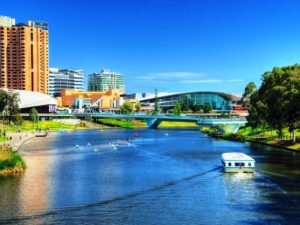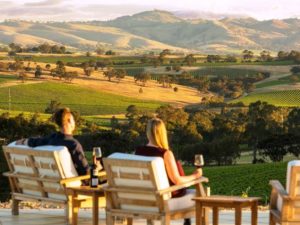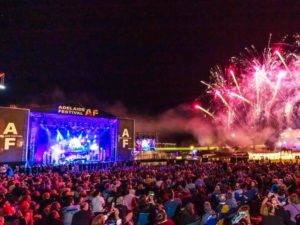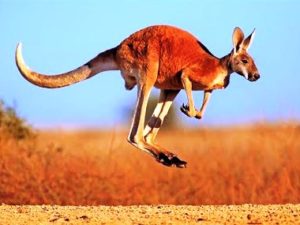Archive for July 24th, 2022
» posted on Sunday, July 24th, 2022 by Linda Lou Burton
All About Adelaide
Originally Published July 25, 2020 by Linda Lou Burton posting about Adelaide, Australia from Little Rock, Arkansas – It’s hard to leave Adelaide. I would have scheduled a much longer stay for the RTW, but, when you have only a week to visit an entire continent the size of the US, you have to keep moving. And the mysterious Outback calls.
 But before I leave, let’s talk about Adelaide, the capital city of the state of South Australia. It’s not only a great place to visit, it’s an even better place to live. It consistently ranks in the Top 10 of “World’s Most Livable Cities” as surveyed by the Economist Intelligence Unit, which measures a city’s Stability, Infrastructure, Education, Environment & Culture, and Healthcare (both quality and availability). Melbourne and Sydney also ranked in the Top 10, you can’t go wrong in Australia!
But before I leave, let’s talk about Adelaide, the capital city of the state of South Australia. It’s not only a great place to visit, it’s an even better place to live. It consistently ranks in the Top 10 of “World’s Most Livable Cities” as surveyed by the Economist Intelligence Unit, which measures a city’s Stability, Infrastructure, Education, Environment & Culture, and Healthcare (both quality and availability). Melbourne and Sydney also ranked in the Top 10, you can’t go wrong in Australia!
Pristine beaches and world-class vineyards don’t hurt a city’s livability quotient, nor does a moderate climate with hot dry summers and mild cool winters. South Australia has two nicknames – The Wine State and The Festival State – and I promised to tell you which I found to be most true. The answer: both are well-deserved!
South Australia’s Wine
 Adelaide is not only South Australia’s capital city, it is the wine capital of Australia – and one of the nine Great Wine Capitals of the World, alongside Bordeaux in France, Napa Valley in the US and Bilbao Rioja in Spain. There are 18 wine regions in South Australia, here is just a sampling:
Adelaide is not only South Australia’s capital city, it is the wine capital of Australia – and one of the nine Great Wine Capitals of the World, alongside Bordeaux in France, Napa Valley in the US and Bilbao Rioja in Spain. There are 18 wine regions in South Australia, here is just a sampling:
- Barossa. Over 80 cellar doors, along with five-star retreats. Due to its Mediterranean climate Cabernets and Shiraz’ are unbeatable.
- McLaren Vale. Over 70 cellar doors only 40 minutes from Adelaide, close to stunning coastal vistas. World-class Shiraz, Grenache, Cabernet Sauvignon, Chardonnay.
- Clare Valley. Over 40 cellar doors just a scenic 90 minute drive from Adelaide; the Riesling and Rattler Trail cycle path winds through the countryside.
- Coonawarra. The Coonawarra is Australia’s top producer of premium red wines. Its wineries also sell some of the best local produce available.
- Adelaide Hills. 60 wineries just minutes from Adelaide and one of Australia’s best cool-climate wine regions.
The University of Adelaide’s National Wine Centre is the showcase for the Australian wine industry. It provides important links with the wine industry, is an important platform for wine education and research, and provides a world class venue for food and wine. A visit there shows the winemaking process from vine to bottle; the Wined Bar offers over 120 wines for tasting. Nestled in the city’s Botanic Gardens. https://nationalwinecentre.com.au/
South Australia’s Festivals
 Go back to 1960, when the Adelaide Festival of Arts was established with backing of the city and city businesses. Then along came the Adelaide Fringe – an unofficial series of performances and exhibits. In 1970 construction of the Adelaide Festival Center began; add the South Australian Film Corporation in 1972, the State Opera of South Australia in 1976. It all kept growing.
Go back to 1960, when the Adelaide Festival of Arts was established with backing of the city and city businesses. Then along came the Adelaide Fringe – an unofficial series of performances and exhibits. In 1970 construction of the Adelaide Festival Center began; add the South Australian Film Corporation in 1972, the State Opera of South Australia in 1976. It all kept growing.
The Adelaide Festival expanded to include Adelaide Writers’ Week and WOMADelaide, an open-air festival in Botanic Park celebrating the World of Music, Arts & Dance. Then came the Adelaide Cabaret Festival, the Adelaide Festival of Ideas, the Adelaide Film Festival, FEAST, Tasting Australia (food and wine, yum). Ever heard of MAD MARCH? Combine the Festival, the Fringe, WOMADelaide, Writers’ Week and the Adelaide 500 street motor racing event, along with evening music concerts all happening at the same time, and you have earned a sure-enough festival reputation.
There are also many international cultural fairs in Adelaide, such as the German Schützenfest and Greek Glendi. The Adelaide Christmas Pageant includes the southern hemisphere’s largest Christmas parade. Yes, Santa shows up in a beard and the floats are decorated with snowmen, though it is warm-weather time there.
There are too many live music and theatre venues to count; Lonely Planet labeled Adelaide “Australia’s live music city,” and Adelaide was recognized as a “City of Music” by the UNESCO Creative Cities Network.
- Next Adelaide Festival 26 Feb – 14 Mar 2021 https://www.adelaidefestival.com.au/
- WOMADelaid https://www.womadelaide.com.au/
- Adelaide November Christmas Pageant https://www.christmaspageant.com.au/
So what do you think? Is South Australia The Wine State, or The Festival State?
As for the capital city of Adelaide, I haven’t yet mentioned EDUCATION (an educational hub, it’s known as a Learning City, three Nobel laureates completed education at St Peter’s College and the University of Adelaide), or SPORTS (home of two Australian Football League teams and one A-League soccer team).
But you should know this HISTORY of Adelaide, population today 1,345,777.
- Named for Queen Adelaide
- Founded in 1836 as the planned capital for the only freely settled British province in Australia
 Located close to the River Torrens in the area originally inhabited by the Kaurna people and known as Tarndanyangga, place of the red kangaroo
Located close to the River Torrens in the area originally inhabited by the Kaurna people and known as Tarndanyangga, place of the red kangaroo- Designed by William Light in a grid layout, interspaced by wide boulevards and large public squares, and entirely surrounded by parklands
The new city attracted immigrants from many parts of Europe; German Lutherans in 1838 brought vine cuttings with them that were used to found the wineries of the Barossa Valley; other Europeans escaping religious persecution were attracted to a city founded on religious tolerance; it’s known today as a City of Churches. St Francis Xavier’s Cathedral was consecrated in 1858; the Central Adelaide Mosque, built to accommodate the spiritual needs of Afghan cameleers, is Australia’s oldest permanent mosque.
 Which leads to one last historical tidbit, as I prepare to head north to the “red center” of Australia. The Afghan community in Australia became established in the 1860s when camels and their handlers were used to open up settlement in the continent’s arid interior. Until the advent of railways and motor vehicles, camels played an invaluable economic and social role in transporting heavy loads of goods to and from isolated settlements and mines.
Which leads to one last historical tidbit, as I prepare to head north to the “red center” of Australia. The Afghan community in Australia became established in the 1860s when camels and their handlers were used to open up settlement in the continent’s arid interior. Until the advent of railways and motor vehicles, camels played an invaluable economic and social role in transporting heavy loads of goods to and from isolated settlements and mines.
Now you know why the passenger train between Adelaide and Darwin came to be named The Ghan, a story I’ll tell more about tomorrow, from Alice Springs.
